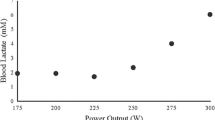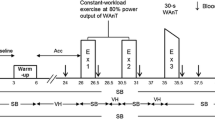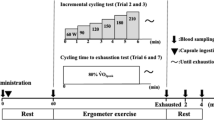Abstract
Few studies evidenced an enhancement in oxygen uptake \(\left( {\dot V{\text{O}}_2 } \right)\) during submaximal exercise in hyperoxia. This O2 “overconsumption” seems to increase above the lactate threshold. The aim of this study was to determine whether the hyperoxia-induced enhancement in \(\dot V{\text{O}}_2 \) may be related to a higher metabolism of lactate. Nine healthy males (aged 23.1 years, mean \(\dot V{\text{O}}_2 \max \) = 53.8 ml min−1 kg−1) were randomized to two series of exercise in either normoxia or hyperoxia corresponding to an inspired O2 fraction (FIO2) of 30%. Each series consisted of 6 min cycling at 50% \(\dot V{\text{O}}_2 \max \) (Moderate1), 5 min cycling at 95% \(\dot V{\text{O}}_2 \max \) (Near Max) and then 6 min at 50% \(\dot V{\text{O}}_2 \max \) (Moderate2). In both series Near Max was performed in normoxia. \(\dot V{\text{O}}_2 \) was significantly greater under hyperoxia than in normoxia during Moderate1 (2192±189 vs. 2025±172 ml min−1) and during Moderate2 (2352±173 vs. 2180±193 ml min−1). However, the effect of the high FIO2 was not significantly different on \(\dot V{\text{O}}_{2{\text{Moderate}}2} \) (+172±137 ml min−1 with [La] ~ 6 mmol l−1) compared to \(\dot V{\text{O}}_{2{\text{Moderate}}1} \) (+166±133 ml min−1 with [La] ~ 2.4 mmol l−1). [La] at the onset of Moderate2 was not different between normoxia and hyperoxia (10.1±2.2 vs. 10.9±1.6 mmol l−1). The results show that \(\dot V{\text{O}}_2 \) is significantly increased during moderate exercise in hyperoxia. But this O2 overconsumption was not modified by a high [La] induced by a prior heavy exercise. It could be concluded that lactate accumulation is not directly responsible for the increase in O2 overconsumption with intensity during exercise in hyperoxia.



Similar content being viewed by others
References
Adams RP, Cashman PA, Young JC (1986) Effect of hyperoxia on substrate utilization during intense submaximal exercise. J Appl Physiol 61:523–529
Anzueto A, Brassard JM, Andrade FH, Lawrence RA, Maxwell LC, Levine SM, Jenkinson SG (1994) Effects of hyperoxia on rat diaphragm function. J Appl Physiol 77:63–68
Byrnes WC, PM Mihevic, PS Freedson, SM Horvath (1984) Submaximal exercise quantified as percent of normoxic and hyperoxic maximum oxygen uptakes. Med Sci Sports Exerc 16(6):572–577
Dean JB, Mulkey DK, Henderson RA III, Potter SJ, Putnam RW (2004) Hyperoxia, reactive oxygen species, and hyperventilation: oxygen sensitivity of brain stem neurons. J Appl Physiol 96:784–791
Eynan M, Arieli Y, Arieli R, Bomzon A (2003) Hyperoxia may reduce energetic efficiency in the trained rat. Aviat Space Environ Med 74:1029–1033
Graham TE, Wilson BA (1983) Effects of hypercapnia and hyperoxia on metabolism during exercise. Med Sci Sports Exerc 15:514–519
Hogan MC, Cox RH, Welch HG (1983) Lactate accumulation during incremental exercise with varied inspired oxygen fractions. J Appl Physiol 55: 1134–1140
Hornby L, Coates AL, Lands LC (1995) Effect of analyser on determination of mixed venous PCO2 and cardiac output during exercise. J Appl Physiol 79(3):1032–1038
Howley ET, Cox RH, Welch HG, Adams RP (1983) Effect of hyperoxia on metabolic and catecholamine responses to prolonged exercise. J Appl Physiol 54: 59–63
Knight DR, Schaffartzik W, Poole DC, Hogan MC, Bebout DE, Wagner PD (1993) Effects of hyperoxia on maximal leg O2 supply and utilization in men. J Appl Physiol 75: 2586–2594
Knight DR, Poole DC, Hogan MC, Bebout DE, Wagner PD (1996) Effect of inspired O2 concentration on leg lactate release during incremental exercise. J Appl Physiol 81:246–251
Linnarsson D, Karlsson J, Fagraeus L, Saltin B (1974) Muscle metabolites and oxygen deficit with exercise in hypoxia and hyperoxia. J Appl Physiol 36: 399–402
Linossier MT, Dormois D, Arsac L, Denis C, Gay JP, Geyssant A, Lacour JR (2000) Effect of hyperoxia on aerobic and anaerobic performances and muscle metabolism during maximal cycling exercise. Acta Physiol Scand 168: 403–411
Nielsen HB, Madsen P, Svendsen LB, Roach RC, Secher NH (1998) The influence of PaO2, pH and SaO2 on maximal oxygen uptake. Acta Physiol Scand 164:89–97
Nielsen HB, Boushel R, Madsen P, Secher NH (1999) Cerebral desaturation during exercise reversed by O2 supplementation. Am J Physiol 277:H1045–H1052
Nielsen HB, Clemmesen JO, Skak C, Ott P, Secher NH (2002) Attenuated hepatosplanchnic uptake of lactate during intense exercise in humans. J Appl Physiol 92:1677–1683
Pattwell DM, Jackson MJ (2004) Contraction-induced oxidants as mediators of adaptation and damage in skeletal muscle. Exerc Sport Sci Rev 32:14–18
Pedersen PK, Kiens B, Saltin B (1999) Hyperoxia does not increase peak muscle oxygen uptake in small muscle group exercise. Acta Physiol Scand 166:309–318
Peltonen JE, Rantamaki J, Niittymaki SP, Sweins K, Viitasalo JT, Rusko HK (1995) Effects of oxygen fraction in inspired air on rowing performance. Med Sci Sports Exerc 27: 573–579
Peltonen JE, Tikkanen HO, Ritola JJ, Ahotupa M, Rusko HK (2001a) Oxygen uptake response during maximal cycling in hyperoxia, normoxia and hypoxia. Aviat Space Environ Med 72: 904–911
Peltonen JE, Tikkanen HO, Rusko HK (2001b) Cardiorespiratory responses to exercise in acute hypoxia, hyperoxia and normoxia. Eur J Appl Physiol 85:82–88. DOI 10.1007/s004210100411
Plet J, PK Pedersen, FB Jensen, JK Hansen (1992). Increased working capacity with hyperoxia in humans. Eur J Appl Physiol Occup Physiol 65(2):171–177
Ploutz-Snyder LL, Simoneau JA, Gilders RM, Staron RS, Hagerman FC (1996) Cardiorespiratory and metabolic adaptations to hyperoxic training. Eur J Appl Physiol 73:38–48
Poole DC (1994) Role of exercising muscle in slow component of VO2. Med Sci Sports Exerc 26:1335–1340
Powers SK, Ji LL, Leeuwenburgh C (1999) Exercise training-induced alterations in skeletal muscle antioxidant capacity: a brief review. Med Sci Sports Exerc 31:987–997
Prieur F, Busso T, Castells J, Bonnefoy R, Benoit H, Geyssant A, Denis C (1998) Validity of oxygen uptake measurements during exercise under moderate hyperoxia. Med Sci Sports Exerc 30:958–962
Prieur F, Benoit H, Busso T, Castells J, Geyssant A, Denis C (2002) Effects of moderate hyperoxia on oxygen consumption during submaximal and maximal exercise. Eur J Appl Physiol 88: 235–42. DOI 10.1007/s00421–002–0707–0
Richardson RS, Grassi B, Gavin TP, Haseler LJ, Tagore K, Roca J, Wagner PD (1999) Evidence of O2 supply-dependent VO2 max in the exercise-trained human quadriceps. J Appl Physiol 86:1048–1053
Scholander PF (1947) Analyzer for accurate estimation of respiratory gases in one-half cubic centimeter samples. J Biol Chem 167:235–250
Sjodin B, Hellsten Westing Y, Apple FS (1990) Biochemical mechanisms for oxygen free radical formation during exercise. Sports Med 10: 236–254
Tonkonogi M, Walsh B, Svensson M, Sahlin K (2000) Mitochondrial function and antioxidative defence in human muscle: effects of endurance training and oxidative stress. J Physiol 528(Pt 2):379–388
Walsh ML, Banister EW (1995) The influence of inspired oxygen on the oxygen uptake response to ramp exercise. Eur J Appl Physiol Occup Physiol 72: 71–5
Welch HG (1982) Hyperoxia and human performance: a brief review. Med Sci Sports Exerc 14: 253–262
Welch HG, Pedersen PK (1981) Measurement of metabolic rate in hyperoxia. J Appl Physiol 51: 725–31
Welch HG, Bonde-Petersen F, Graham T, Klausen K, Secher N (1977) Effects of hyperoxia on leg blood flow and metabolism during exercise. J Appl Physiol 42:385–390
Wilber RL, Holm PL, Morris DM, Dallam GM, Callan SD (2003) Effect of FIO2 on physiological responses and cycling performance at moderate altitude. Med Sci Sports Exerc 35:1153–1159. DOI 10.1249/01.MSS.0000074495.34243.B5
Wilber RL, Holm PL, Morris DM, Dallam GM, Subudhi AW, Murray DM, Callan SD (2004) Effect of FIO2 on oxidative stress during interval training at moderate altitude. Med Sci Sports Exerc 36(11):1888–1894. DOI 10.1249/01.MSS.0000145442.25016.DD
Wilson BA, Welch HG, Liles JN (1975) Effects of hyperoxic gas mixtures on energy metabolism during prolonged work. J Appl Physiol 39: 267–271
Author information
Authors and Affiliations
Corresponding author
Additional information
The authors declare that the experiments comply with the current French laws.
Rights and permissions
About this article
Cite this article
Favier, F.B., Prieur, F., Grataloup, O. et al. A high blood lactate induced by heavy exercise does not affect the increase in submaximal \(\dot V{\text{O}}_2 \) with hyperoxia. Eur J Appl Physiol 94, 107–112 (2005). https://doi.org/10.1007/s00421-004-1310-3
Received:
Accepted:
Published:
Issue Date:
DOI: https://doi.org/10.1007/s00421-004-1310-3




